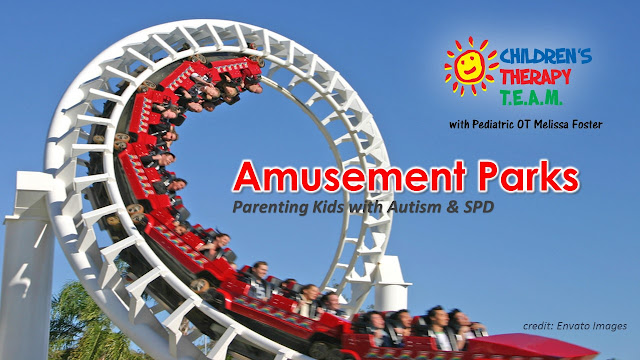Dear Melissa,
My family wants to visit an amusement park on our family
vacation this year. Any tips for my 6-year-old with Autism to make the experience more enjoyable for everyone?
I have personally been to the amusement park with
individuals with both physical disabilities and Autism. In my experience, the
staff tends to be extremely helpful and bends over backwards when they see an
individual in a wheelchair. But when the
special need is less visually obvious, the staff become very suspicious: Does your child really have a special need, or are you just being a whiny guest?
Therefore, this blog is for children with more “hidden”
disabilities such as Autism. Here are some helpful tips to make the most of your next trip to the amusement
park:
Keep
Routine
In general, routine is your
best friend for all children, and especially children with Autism. As much as possible, keep meal times, snack
times, rest/nap time, and bed/wake times the same as a typical
day.
Bring
snacks
Hungry children are grouchy
children. Make sure you keep plenty of
snacks on hand to ward off both boredom and grouchy hunger pains. Also, keep in mind special dietary needs or allergies,
as your options may be limited once inside the park. It has been my experience
that most snack stands will have a book of item ingredients and allergens if
you ask.
Have a
plan for long lines
Don’t just have an A and B plan for waiting in line. Make sure you have plans C, D, E, F, and G
as well! Fidget toys, snacks, books, handheld games, earphones/music, jumping jacks, eye spy…all can be good distractions for waiting in line. But a word of caution: don’t
bring your child’s absolute favorite toy if it can be avoided. There is a high likelihood of it becoming
lost in all of the excitement.
Avoid
crowds
Me: “Hey, I hear you are going to Silver Dollar
City on Saturday!!!”
Kiddo: “Um…I don’t like to be around that many
people…”
What? What kind of response is that? The response of a person who has Autism. If your child has this reaction, try to avoid
weekends, holidays, and other times when you know the park will be the most
crowded. Some places, such as
Disney World, even have crowd calendars so you can plan your trip during less
busy seasons.
Dealing
with noise/crowds once you are there
If your child will tolerate ear buds or headphones, consider using these
to block out extra sounds. A hoodie can
also be pulled over his head to help muffle sounds. In addition, ask around and find a couple of quiet corners of the park
where you can take a breath and relax a bit before joining back in the
fun!
Know your
child’s ride tolerance
I am
completely guilty of “therapizing” my biological children at amusement
parks. I regularly push the envelope (just
a bit) and make them ride rides slightly outside their comfort zone. However, if your child is hesitant to go on the merry-go-round at the park, then he will
probably be terrified by a roller coaster. So don’t do it! On the other hand, many kiddos with Autism and ADHD
are complete sensory seekers and can’t find a roller coaster fast enough. If you have a sensory seeker, make sure you
pair him with an adult who can tolerate these types of rides so nobody gets
sick! Bottom line, know your child and
choose rides accordingly.
Know your
child’s walking tolerance
Normally,
I would never put a 7 or 8-year-child in a stroller, but this is totally the
exception. Shoot, I want to use a
stroller at the park! If the child can
fit in it, then use it! An added bonus
is that the stroller can also help prevent the temptation for the child to
wander off.
Put an ID
bracelet on your child
Have a way
to ID your child if he gets lost or tends to wanders off. Use a bracelet with your child’s name, your
name, and your cell phone number so
staff can find you quickly if your child becomes lost. You may want to check with the amusement park.
Many have stations that will provide these ID bracelets for your child and measure your child so you know which rides he is tall enough to
ride. But a word of warning: many children
are resistant to these wrist bands due to sensory sensitivities. Other options may be to put the wristband on
a belt loop, shoe lace, or ankle.
Role play
As with everything in life, practice makes perfect! Talk about what to expect at the park. Practice waiting in line. Watch videos of the
rides and other aspects of the park. Basically, make sure that the park is a familiar place before you even walk through the
gates.
What amusement parks will your family be visiting this
summer?
What worked and what did
not?
Please share! www.share@childrenstherapyteam.com
Resources:
39 Theme Parks with Special Needs Access Passes by Karen Wang (Posted 2013), accessed June 2015
Walt Disney World: Services for Guests with cognitive disabilities, accessed June 2015
Tips on Enjoying Amusement Parks for Kids with Autism, MetroParent.com, accessed June 2015

